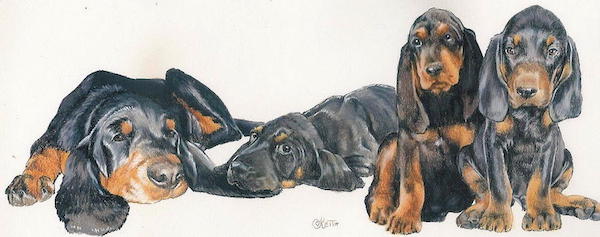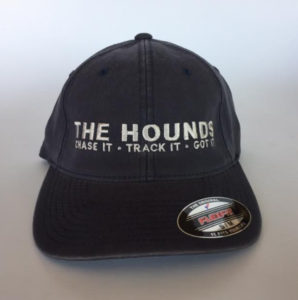
When the American Kennel Club officially recognized the Black and Tan Coonhound in 1945, it became the first of the coonhounds to earn recognition by the organization, fitting since the breed dates all the way back to America’s frontier days (the United Kennel Club first registered Black and Tans in 1912, but when the breed was first acknowledged by the UKC, it was called the American Black and Tan Fox and Coonhound).
The breed’s story begins with settlers who headed west after the revolutionary era, but once in the wilderness, they had to contend with a formidable critter: The raccoon.
Today’s Geico commercials notwithstanding, these were not easy animals to like: They raided gardens, damaged crops, stole chickens, and made a mess in barns. They ate anything and everything, and their paws – 30 times more sensitive than human hands – meant that they could open barrel latches, boxes, and any other thing they had a mind to open. The upside was that for a frontier family, they were a good source of meat, fat, and fur (Native American tribes even used the animal’s s-shaped penis bone as a pipe-cleaning tool). Coonskin caps were quite warm, and the skins could be substituted for money to purchase goods at trading posts.
Problem was, there didn’t exist a dog that could hunt a raccoon. Foxhounds owned by the southern gentry weren’t suited for the terrain, and their “hot” nose meant the dogs could only follow a fresh track. Frontier families needed a whole new kind of hound.
They crossed Foxhounds and Bloodhounds which contributed the genes of their ancestors, the St Hubert bloodhound, Kerry Beagle, French Bleu Gascogne hounds, the Talbot hound, and the Virginia hound, to the new breed named for its color: Black and Tan.
Now the frontiersman was in business.
Their new dogs were big, sturdy, and strong, and they were “all terrain” canines undaunted by swamps, woods, hills and dales. They had clear, musical baying that marked their location, and they hunted (still do) in a painstaking and insistent manner even after the trail went ‘gone cold.’ These dogs were known to tree a raccoon long after their handler gave up, and they came to be respected for having one of the best cold noses of all dogs.
In fact, Daniel Boone and Davy Crockett, both usually wearing coonskin caps in the movies, were both Black and Tan Coonhound enthusiasts. Daniel Boone even remarked that “his favorite of all hounds were those dark colors, primarily of black and tan.”
This early history of the breed gave rise to one more factoid: Tracking raccoons with dogs is the only hunting sport to use dogs that originated in America.
Fans of the Black and Tan will want to read the following cute legend associated with the breed:
These days, most coonhound owners don’t wear coonskin caps, but they wear the one below. It reads: The Hounds: Chase it • Track it • Got it

The embroidered Flexfit® Stone Washed Twill hat is the original comfort-fit baseball cap. A closed back means there’s no plastic snap to break, nor velcro that snags your hair. Get your cap here now!
Image: Black and Tan Coonhound puppies by Barbara Keith
http://barbara-keith.fineartamerica.com
http://barbara-keith.artistwebsites.com/
http://www.redbubble.com
http://www.zazzle.com/barbbarcikkeith
